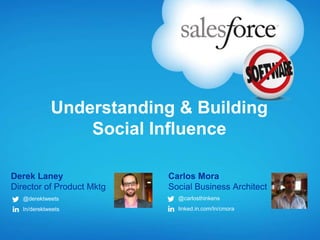
How to Measure & Build Social Influence
- 1. Understanding & Building Social Influence Derek Laney James Dellow Director of Product Mktg Social Business Consultant salesforce.com Ripple Effect @derektweets @chieftech In/derektweets In/chieftech
- 2. Welcome to the Reputation Economy
- 4. Sources of Influence – Not all about reach
- 5. Measuring Influence Can you move What do you Who Responds Content? talk about?
- 6. Example
- 8. Or Game it
- 9. More… Download our latest eBook
- 10. Value or Vanity?
- 11. Understanding & Building Social Influence In Employee Social Networks James Dellow – Ripple Effect Group Social Business Design Consultant @chieftech linked.in.com/In/chieftech
- 12. Organisations are still made of people.
- 13. “The greatest predictor of success and happiness at work is social support.”
- 14. Why build personal brand internally? • Influence beyond the influence of your role • Create an internal network that can overcome inefficient information flow (including information gatekeepers) • Build and maintain social capital with weak ties - colleagues you do not know well or previously worked with • Social support – organisations are made of people who want to connect with each other • Career advancement, by demonstrating expertise or participation in a community of practice
- 15. How can you use social networking internally? • Technology (enterprise social software) • allows you to build and maintain strong and weak relationships that would not otherwise be possible in a modern, large organisation. • You maintain strong and weak relationships online through: • Social capital – active engagement with others, showing reciprocity and working together online • Connecting - Referring people to other people, information or resources that can help them • Knowledge sharing - Demonstrating expertise • Tips: • Maintain your user profile • Engage purposefully, online & offline
- 16. Case Study: Social Learning • Executive Coaching program • Objective: Social Learning • Extend participant engagement at pre- and post-work stages of training programs • Create a sense of community to reinforce learning • Target Audience: 2,500+ participants • Results • 95% course completion rates • 80% continue program • Deeper levels of learning • Source: Ripple Effect Group
- 17. THANK YOU
- 18. Social Intelligence: Discover What’s Important Influence and Topic Trends Recommendations Identify the Influencers and Trends Connect Users to Relevant, People, Across your Company and Community Groups, Files and Data from Anywhere Topic Pages Contextual Topic Suggestions Recommendations (Process-Specific) Topical Influence
- 19. Using Business Social Networks Collaborate with members of Customer teams Communicate within departments and across functional groups
- 20. Using Business Social Networks Collaborate on sales efforts Get quick answers and best practices from experts
- 21. Using Business Social Networks Instantly view the latest updates to critical opportunities, cases, etc. Manual and automated updates immediately appear in the Chatter feed
- 22. Using Business Social Networks Share your work and ideas Ask complex questions – get complex, accurate answers quickly
- 23. Using Business Social Networks Communicate “What am I working on” or “Where am I?” Share your own expertise and work experience
- 24. Using Business Social Networks Major Events: post general information One-off Groups: Communicate with in your own community
- 25. Share wins so everyone benefits “Highlight wins vs. competitors so every sales person can turn a recent win into a competitive weapon”
- 26. Other Uses of Employee Networks? • Find other experts • Communicate your status • Improve communication on global groups and projects • Share best practices • Use chatter as an employee directory • Celebrate achievements and success • Collaborate privately on sensitive projects • Stay connected with colleagues
Editor's Notes
- StackOverflow – Community Help becomes a Measure of Employment sorting through too much irrelevant and incorrect informationMovenbank – CRED friends, network activityReputation is as valuable as moneyhttp://www.wired.co.uk/magazine/archive/2012/09/features/welcome-to-the-new-reputation-economy?page=all
- Robert Cialdini – Influence – the psycology of persuasionScarcity – we want things that are rareLikability – we follow people we likeConsistency – we continue once we have committed to a goal http://www.flickr.com/photos/stargardener/5178063063/Authority – we follow authority figuresSocial Proof – we do what others doReciprocity – we want to pay back value we receive Adam Ferrier
- Traditional influence using reach – athletes, movies, musicians, modelsNiall from OneDirection,Over 3M social posts a day about themCitizen Influencer – Molly Catchpole300K signatures in 2 weeks to stop bank feesIn 3 weeks BoA changed their stancehttp://www.change.org/petitions/tell-bank-of-america-no-5-debit-card-feesUnited breaks guitars, incredibly influencial video created by a non-influencerhttp://en.wikipedia.org/wiki/United_Breaks_GuitarsHP Labs Study – reach /= influencehttp://www.scribd.com/doc/35401457/Influence-and-Passivity-in-Social-Media-HP-Labs-ResearchPerson of the Year 2011 – the protesterhttp://www.time.com/time/specials/packages/printout/0,29239,2101745_2102132_2102373,00.html
- Relevant MeaningfulConsistentRITERelevantInterestingTimelyEntertainingContent Strategy – what to say Interesting and unique story and valueNetwork Strategy – how to share it
- Any algorithm can be gamed, it doesn’t necessarily make the algorithm wrong, but we need to be aware.
- There are thousands of great ways to use Chatter. But here are just a few that have transformed our company here at salesforce.com as well as many of our customers.
- How can you use social networking internally?Technology (enterprise social software) allows you to build and maintain strong and weak relationships that would not otherwise be possible in a modern, large organisation.You maintain strong and weak relationships online through:Social capital – active engagement with others, showing reciprocity and working together online. Connecting - Referring people to other people, information or resources that can help them.Knowledge sharing - Demonstrating expertise.Tips:Maintain your userprofileEngage purposefully, online & offline
